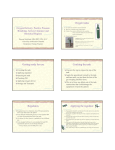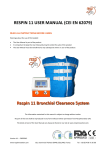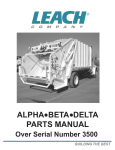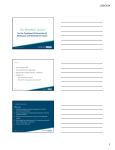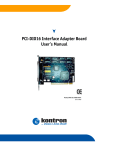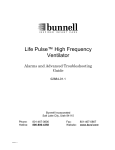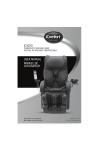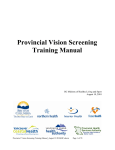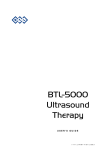Download to view user manual.
Transcript
INSTRUCTION MANUAL T V model v2 - v2x Acoustical airway clearance device Rev. 14.05.22 SAFETY SYMBOLS This manual uses the following safety symbols. They denote critical information. Please read them carefully. WARNING Failure to abide by the information with a WARNING may result in serious injury and can be life threatening. CAUTION Failure to abide by the information with a CAUTION may result in moderate injury and/or property or product damage. INDICATES A PROHIBITED ACTION TYPE B EQUIPMENT ALTERNATING CURRENT DIRECT CURRENT ELECTROMAGNETIC RADIATION INDOOR USE ONLY Copyright © by Dymedso inc. All rights reserved. No part of this manual may be reproduced, stored in a retrieval system, or transmitted, in any form or by any means, electronic, mechanical, or otherwise, without the prior written permission of Dymedso inc. Dymedso inc. is under no obligation to hold any submitted material or information confidential unless prior arrangements are made pursuant to Dymedso’s receipt of said information. Although every effort has been made to ensure that this manual provides up-to-date information, please note that Dymedso’s Frequencer™ specifications are subject to change without notice. Frequencer™ is a registered trademark of Dymedso inc. 01_ The FrequencerTM instruction manual Table of Contents [ 1 ] Indications for use 3 [ 2 ] Contraindications 4 [ 3 ] General Information 5 [ 4 ] Description 5 [ 4_a ] The components 5 [ 4_b ] Control unit functionalities 7 [ 4_c ] Control unit connections 8 [ 5 ] Treatment in a controlled environment 8 [ 6 ] Preparing for treatment 8 [ 7 ] Treatment with the Frequencer™ 9 [ 8 ] Cleaning [ 9 ] Maintenance 11 [ 10] Storage 11 [ 11 ] Assistance 11 [ 12] Disposal 12 [ 13] Problem solving 12 [ 14] Specifications 13 [ 15] EMC requirements 14 [ 16] ESD precautionary procedures 18 The FrequencerTM instruction manual 10 _02 [1] Indications for use The Frequencer™ provides airway clearance therapy and promotes bronchial drainage by inducing vibration in the chest walls. This device is intended to be a component of chest physiotherapy by providing a convenient method of external thorax manipulation. It is intended for patients having respiratory ailments which involve defective mucociliary clearance, as is typical in patients suffering from cystic fibrosis as well as chronic bronchitis, bronchiectasis, ciliary dyskinesia syndromes, asthma, muscular dystrophy, neuromuscular degenerative disorders, post-operative atelectasis and thoracic wall defects. Indications for this form of therapy are described in the Clinical Practice Guidelines for Postural Drainage Therapy of the American Association for Respiratory Care (AARC) published in 1991. This particular device provides a gentler, less painful form of therapy from the traditional “clapping” method of postural drainage therapy, allowing it to be used on patients who cannot be treated by clapping. The Frequencer™ is suitable for use in all environments including domestic environments. WARNING: Use only original FrequencerTM parts or replacement parts sold by Dymedso. Do not substitute the power supply. Power supply must be an ASTEC model DPS55-M. WARNING: If patient experiences any discomfort or pain while using the Frequencer™, stop the treatment and consult a physician. WARNING: This instruction manual is not intended to supersede established medical protocols. WARNING: This device is not a form of life support. WARNING: Repairs must be performed by the manufacturer, the manufacturer’s distributor or authorized agent. Do not open this equipment including the transducer or the power supply. WARNING: This equipment is not suitable for use in the presence of a flammable anaesthetic mixture in combination with oxygen or air, or in the presence of nitrous oxide. WARNING: To avoid electrical shock, disconnect the power cord before cleaning. Do not immerse the device in any fluids. 03_ The FrequencerTM instruction manual [2] Contraindications IT IS IMPORTANT TO READ AND UNDERSTAND THE FOLLOWING CONTRAINDICATIONS. IF YOU HAVE ANY QUESTIONS ABOUT YOUR CONDITION OR THE USE OF YOUR FREQUENCER™, CONSULT YOUR PHYSICIAN. WARNING: Tests with the Frequencer™ were performed with patients in a sitting or slightly reclined position. Use of the Frequencer is contraindicated in the following cases: _subcutaneous emphysema _recent epidural spinal infusion or spinal anesthesia _recent skin grafts, or flaps, on the thorax _burns, open wounds, and skin infections of the thorax _subcutaneous pacemaker _tuberculosis of the lungs _lung contusion _bronchospasm _osteomyelitis of the ribs _osteoporosis _coagulopathy _complaint of chest-wall pain WARNING: When postural drainage is used, postural drainage therapy is generally contraindicated if any of the following conditions are present: _intracranial pressure (ICP) > 20 mm Hg _recent head and/or neck injury _acute spinal injury or active hemoptysis _esophageal surgery _recent spinal surgery (eg, laminectomy) or acute spinal injury _recent neurosurgery, aneurysms, or eye surgery _surgical wound or healing tissue _active hemorrhage with hemodynamic instability _emphysema _bronchopleural fistula _pulmonary edema associated with congestive heart failure _large pleural effusions _pulmonary embolism _intolerance of position changes _rib fracture, with or without flail chest _uncontrolled hypertension _distended abdomen _recent gross hemoptysis related to recent lung carcinoma treated surgically or with radiation therapy _uncontrolled airway at risk for aspiration (tube feeding or recent meal If you are uncertain about any of the information, consult your physician. The FrequencerTM instruction manual _04 [3] General Information This instruction manual is designed to help you use the Frequencer™. If you have any questions about the effectiveness of the Frequencer™, or about the frequency level, treatment intensity and duration of the treatments, please consult your physician. Read this manual carefully before using the Frequencer™ for the first time. [4] Description [4_A] THE COMPONENTS The Frequencer™ includes a basic module to control frequency level and treatment intensity (control unit), and a transducer which emits acoustic waves. TRANSDUCER CONTROL UNIT The Frequencer™ operates with: 1_One (1) power supply 2_One (1) grounded electrical cable (110V AC) THE FREQUENCER™ ACCESSORIES INCLUDE: 3_Four different sized adapters To optimize treatment efficiency with patients of all ages, four different sizes of adapters can be fitted on the transducer: The adapter with a 1” opening is for very small children. The adapter with a 2” opening is for children. The adapter with a 3” opening is for young adults. The adapter with a 4” opening is for adults. 05_ The FrequencerTM instruction manual For hospitals and usage in multi-patient settings, we recommend the Frequencer™ v2x with disposable adapters and filter. The disposable adapters with filters are sold separately. WARNING: The re-use of disposable adapters with filter between multiple patients may result in cross-patient contamination. For home use and usage by a single patient, the Frequencer™ V2 operates with permanent adapters. The Frequencer™ V2 comes with 4 permanent adapters, one of each size. Frequencer™ V2 and V2x use the same control unit and the same four sizes of adapters. 4_A Roll stand The base of the Frequencer™ is equipped with a fixation plate that enables the device to be attached to a roll stand. The roll stand is sold separately and is recommended for hospital use. TM by 5_Carrying case Canada J7G 2S8 Boisbriand, Quebec, 450.437.2063 Boivin Blvd., (396.3376) F: 901 A, Du Cure 1.877.DYMEDSO T: 450.437.7354 A foam padded carrying case with rollers can also be used to store and protect the Frequencer™. The carrying case is sold separately. 6_Flexible extension hose For situations in which the weight of the transducer causes patient discomfort, a 72 inches flexible extension hose may be affixed to a 1 inch adapter. WARNING: The use of ACCESSORIES, transducers and cables other than those specified, with the exception of transducers and cables sold by Dymedso as replacement parts for internal components, may result in increased EMISSIONS or decreased IMMUNITY of the Frequencer™. The FrequencerTM instruction manual _06 [4_B] CONTROL UNIT FUNCTIONALITIES The interface on the control unit includes a touch screen which offers the following functions: 1_START function to start treatment... PAUSE function appears when the START function is pressed. 2_PAUSE to temporarily suspend treatment. 3_TREATMENT INTENSITY slide UP and DOWN to increase and decrease intensity of treatment. 4_FREQUENCY LEVEL slide UP and DOWN to increase and decrease the frequency level. 5_MENU button offers additional features: LANGUAGE offers a choice of language on the Interface. 3-MINUTE BEEP (YES or NO) emits a beeping sound every 3 minutes. DEFAULT SETTINGS offers a choice of default settings of Baby Level (frequency at 40 Hz and treatment intensity at 10%) or Child Level (frequency at 40 Hz and treatment intensity at 50%). LOCK SETTINGS (YES or NO) limits frequency level changes to 1 Hz and treatment intensity to 1% using + or - buttons only. 1-2 5 3 4 07_ The FrequencerTM instruction manual [4_C] CONTROL UNIT CONNECTIONS A_Plugging in the power supply. B_Power switch. A B [5] Treatment in a controlled environment CAUTION: The Frequencer™ should only be used in normal temperatures and humidity. If, for any reason, the device becomes damp, wait until it dries completely before using it. We do not advise using the Frequencer™ when the temperature exceeds 86°F (30°C) or goes below 50°F (10°C). If the device was exposed to an extreme temperature for a prolonged period (eg, after a long car ride) let it return to room temperature (at least two hours) before using. WARNING: The Frequencer should not be used next to or stacked with any other equipment. If such a placement is necessary, the Frequencer should be closely observed to ensure normal operation. WARNING: The ventilation openings should never be obstructed. [6] Preparing for treatment Before using the Frequencer™ for the first time, please ensure the device has been cleaned as indicated in section 8. STEP 1: Ensure you have all the components (see section 4_A). STEP 2: Connect the power supply to the control unit. STEP 3: Plug the electrical cable into the power supply. STEP 4: Plug the electrical cable into a proper AC electrical outlet. WARNING : INSPECT THE POWER CORD OFTEN FOR ANY SIGNS OF DAMAGE. REPLACE A DAMAGED CORD IMMEDIATELY. The FrequencerTM instruction manual _08 [7] Treatment with the Frequencer™ figure 1 men women STEP 1: Select the correct adapter (i.e., the largest adapter that will form a complete seal when applied to the chest area). Tightly affix the adapter onto the transducer. (Refer to [4_a], The components, for more info on adapters). WARNING: Always make sure that there is an adapter on the transducer before pushing the START button. Do not substitute or modify the adapters supplied by Dymedso; it could seriously damage the transducer. STEP 2: Patient should be in a sitting or slightly reclined position. STEP 3: Push power switch on the back of the Frequencer™ to turn on device. By default, frequency level is set at 40 Hz and treatment intensity at 50%. (Refer to [4_b], Control unit functionalities, to change default settings). STEP 4: Before starting treatment, reset treatment intensity to better suit patient’s size and condition. STEP 5: Place transducer on chest wall and press START. STEP 6: Adjust frequency level one Hz at a time until vibration is felt on back or other part of chest cavity. At the right frequency level, there should be a light vibration in patient’s voice when transducer is applied to the upper lobes. A. Frequency level will most likely be within a 40-50Hz range. B. If patient is able to huff or actively breathe, it may assist with airway clearance. 09_ The FrequencerTM instruction manual STEP 7: Apply transducer to the six areas for 2-3 minutes each. Starting in the lower right and left lobe and working upward on each side. (see page 09, figure 1). NOTE: To optimize the seal, place the transducer with adapter directly onto the skin. If treatment needs to be suspended, PAUSE will hold treatment until START is pressed again. STEP 8: Do not apply any pressure on the transducer when applied to the chest. Simply support transducer while assuring complete seal. Transducer is much easier to support while patient is in a slightly reclined position. STEP 9: After treatment push PAUSE button and turn power switch off before unplugging. NOTE: Following treatment, redness is not uncommon in the area or areas treated by the Frequencer™. CAUTION: ALWAYS FOLLOW THE PHYSICIAN’S INSTRUCTIONS. NEVER USE THIS DEVICE ON THE HEAD OR EARS. [8] Cleaning There are no special procedures or products for cleaning the Frequencer™. Do not use harsh chemicals on any part of the device. We recommend cleaning the Frequencer™ with a damp cloth. To remove stubborn stains, use hot water and mild soap, and wipe off the soap with a dry, clean cloth. CAUTIONS: Do not immerse or rinse the Frequencer™ or its peripherals. If you accidentally spill liquid on the device, disconnect the unit from the power source. Contact your Biomed Department regarding the continued safety of the unit before placing it back in operation. Do not spray cleaning agent on the chassis. Do not use disinfectants that contain phenol. Do not autoclave or clean the Frequencer™ or its peripherals with strong aromatic, chlorinated, ketone, ether, or Esther solvents, sharp tools or abrasives. Never immerse electrical connectors in water or other liquids. WARNING: To avoid electrical shock, disconnect the power cord before cleaning. Do not immerse the device in any fluids. The FrequencerTM instruction manual _10 [9] Maintenance No special maintenance is required. However, the Frequencer™ contains a lithium battery to display the time and date which should work for many years. If it stops working, you must return the unit to the manufacturer, the manufacturer’s distributor or authorized agent to have it replaced. [10]Storage CAUTION: When not in use, put all components in the carrying case and store in a dry place at room temperature. If the device must be exposed to extreme temperatures for a prolonged period (eg during a long car ride), let it return to room temperature before use it. If the device gets wet, let it dry completely before use. [11] Assistance If, for any reason, you do not think the device is working properly, the troubleshooting list below can help you find the cause of the problem. If you cannot solve the problem, contact DYMEDSO Customer Service at 1-877-DYMEDSO (396.3376) or [email protected]. Do not attempt to repair or disassemble the device. This will void the warranty. Under no circumstances should you modify the cable or transformer. Only use products sold by DYMEDSO. Otherwise you could damage your device and void the warranty. 11_ The FrequencerTM instruction manual [12] Disposal When necessary, dispose of the Frequencer™ and its accessories in accordance with local regulations. Please note the device houses a lithium battery. [13] Problem solving PROBLEM POSSIBLE CAUSES The control unit does not start after pressing the POWER SWITCH button. 1. The power supply is not plugged into the device. Verify the connectors are plugged in. 2. Verify the power supply is plugged into a proper power outlet. 3. There is no voltage power in the wall outlet. Verify the outlet is working by plugging in another device (lamp, clock). The control started up but there is no noise coming from the transducer. Make sure the control is not on PAUSE and the treatment intensity is higher than 0%. The transducer works but I cannot adjust the frequency level. Contact DYMEDSO Customer Service. The transducer works but I cannot adjust the treatment intensity. Contact DYMEDSO Customer Service. TO REACH US 1 877.DYMEDSO (396-3376) [email protected] The FrequencerTM instruction manual _12 [14]Specifications PRODUCT USE: Temperature: 10 to 30ºC Humidity: 15 to 95%, non-condensing Atmospheric pressure: 76.7 to 102 kPa TRANSPORT & STORAGE: Temperature: -12 to 60ºC Humidity: 15 to 95%, non-condensing Standards compliance: IEC 60601-1 Mode of operation: Continuous AC power consumption: 100-240Vac. 50/60Hz, 2A Type of protection against electric shock: Class I Degree of protection against electric shock: Type B, Applied part Degree of protection against ingress of water: IPX0, ordinary equipment 13_ The FrequencerTM instruction manual [15] EMC Requirements GUIDANCE AND MANUFACTURER’S DECLARATION ELECTROMAGNETIC EMISSIONS The Frequencer™ should be use in the electromagnetic environments specified below. The user of the Frequencer™ should ensure that it is used in such an environment. ELECTROMAGNETIC ENVIRONMENT GUIDANCE EMISSION TEST COMPLIANCE RF emissions CISPR 11 Group 1, Class B The Frequencer™ uses RF energy only for its internal function. Therefore its RF emissions are very low and are not likely to cause any interference with nearby electronic equipment. RF emissions CISPR 11 Group 1, Class B Harmonic emissions IEC 61000-3-2 Class A None Voltage fluctuations/ Flicker emissions IEC 61000-3-3 Compliant None The Frequencer™ is suitable for use in all establishments, including domestic establishments and those directly connected to the public low-voltage power supply network which supplies buildings used for domestic purposes. The FrequencerTM instruction manual _14 GUIDANCE AND MANUFACTURER’S DECLARATION ELECTROMAGNETIC IMMUNITY The Frequencer™ is intended for use in the electromagnetic environment specified below. The user of the Frequencer™ should ensure it is used in the appropriate environment. IMMUNITY TEST IEC 60601 TEST LEVEL COMPLIANCE LEVEL ELECTROMAGNETIC ENVIRONMENT GUIDANCE Electrostatic discharge (ESD) ±6 kV contact ±6 kV contact Floor should be wood, concrete or ceramic tile. If floors are covered with synthetic material, the ±8 kV air relative humidity should be at least 30%. IEC 61000-4-2 ±8 kV air Electrical fast transient/ burst IEC 61000-4-4 ±2 kV for power supply lines ± 1 kV for input/ output ±2 kV for power supply lines ± 1 kV for input/ output lines Mains power should be that of a typical commercial or hospital environment. Surge IEC 61000-4-5 ± 1 kV line(s) to line(s) ± 2 kV line(s) to earth ± 1 kV line(s) to line(s) ± 2 kV line(s) to earth Mains power should be that of a typical commercial or hospital environment. ESSENTIAL PERFORMANCE OF THE FREQUENCERTM 15_ TYPE MINIMUM MAXIMUM Generated Frequency 20 Hz 65 Hz Sound Pressure Output 0 PSI 0.4 PSI The FrequencerTM instruction manual Voltage dips, short interruptions and voltage variations on power supply input lines IEC 61000-4-11 <5% UT (>95% dip in UT) for 0.5 cycle 40% UT (60% dip in UT) for 5 cycles 70% UT (30% dip in UT) for 25 cycles <5% UT (>95% dip in UT) for 5 s <5% UT (>95% dip in UT) for 0.5 cycle 40% UT (60% dip in UT) for 5 cycles 70% v (30% dip in UT) for 25 cycles <5% UT (>95% dip in UT) for 5 s Mains power quality should be that of a typical home or hospital. If the user of the Frequencer™ requires continued operation during power mains interruptions, it is recommended that the Frequencer™ be powered from an uninterruptible power supply or from a battery. Power frequency (50/60 Hz) Magnetic Field IEC 61000-4-8 3 A/m 3 A/m If the user experiences malfunctions with the Frequencer™, it may be necessary to position the Frequencer™ further from sources of power frequency magnetic fields. The power frequency magnetic field should be measured in the intended installation location to ensure that it is sufficiently low. Note : UT is the AC mains voltage prior to application of the test level. The FrequencerTM instruction manual _16 GUIDANCE AND MANUFACTURER’S DECLARATION ELECTROMAGNETIC IMMUNITY The Frequencer™ is intended for use in the electromagnetic environment specified below. The user of the Frequencer™ should ensure it is used in the appropriate environment. IMMUNITY TEST Conducted RF IEC 61000-4-6 Radiated RF IEC 61000-4-3 IEC 60601 TEST COMPLIANCE LEVEL LEVEL ELECTROMAGNETIC ENVIRONMENT GUIDANCE 3 Vrms 150 kHz to 80 MHz Portable and mobile RF communications equipment should be used no closer to any part of the Frequencer™, including cables, than the recommended separation distance calculated from the equation applicable to the frequency of the transmitter. Recommended separation distance. 3 V/m 80 MHz to 2.5 GHz 3 Vrms 3 V/m d = 1.2√P d = 1.2√P 80 MHz to 800 MHz v = 2.3√P 800 MHz to 2.5 GHz Where P is the maximum output power rating of the transmitter in watts (W) according to the transmitter manufacturer and d is the recommended separation distance in meters (m). Field strengths from fixed RF transmitters, as determined by an electromagnetic site survey, a should be less than the compliance level in each frequency rangeb. 17_ The FrequencerTM instruction manual [16] ESD Precautionary procedures It is recommended that all staff involved in the assembly and/or installation of the Frequencer™ receive an explanation of the ESD warning symbol and training in ESD precautionary procedures. Please refer to the section below on Minimum ESD Procedures. It is recommended by Dymedso that all staff involved in the assembly and/or installation and/or repair of the Frequencer™ receive Explanation and Training in ESD Procedure. MINIMUM ESD PROCEDURES DESIGN IN IMMUNITY by designing products and assemblies to be as immune and reasonable from the effects of ESD. DEFINE THE LEVEL OF CONTROL needed in your environment. IDENTIFY AND DEFINE the electrostatic protected areas (EPA), the areas in which you will be handling sensitive parts. ELIMINATE AND REDUCE GENERATION by reducing and eliminating static generating processes, keeping processes and materials at the same electrostatic potential, and by providing appropriate ground paths to reduce charge generation and accumulation. DISSIPATE AND NEUTRALIZE by grounding, ionization, and the use of conductive and dissipative static control materials. PROTECT PRODUCTS FROM ESD with proper grounding or shunting and the use of static control packaging and materials handling product. The FrequencerTM instruction manual _18 Interference may occur in the vicinity of equipment marked with the following symbol: NOTE 1: At 80 Mhz and 800 MHz, the higher frequency range applies. NOTE 2: These guidelines may not apply in all situations. Electromagnetic propagation is affected by absorption and reflection from structures, objects and people. NOTE 3: Medical Electrical equipment needs special precautions regarding EMC and needs to be installed and put into service according to the EMC information provided in this document. NOTE 4: It is essential that the actual shielding effectiveness and filter attensuation of the shielded location be verified to assure that they meet the minimum specification. Field strengths from fixed transmitters, such as base stations for radio (cellular/cordless) telephones and land mobile radios, amateur radio, AM and FM radio broadcast and TV broadcast cannot be predicted theoretically with accuracy. To assess the electromagnetic environment due to fixed RF transmitters, an electromagnetic site survey should be considered. If the measured field strength in the location in which the Frequencer™ is used exceeds the applicable RF compliance level above, the Frequencer™ should be observed to verify normal operation. If abnormal performance is observed, additional measures may be necessary, such as re-orienting or relocating the Frequencer™. a Over the frequency range of 150 kHz to 80 Mhz, the field strengths should be less than 3 V/m. b 19_ The FrequencerTM instruction manual RECOMMENDED SEPARATION DISTANCES BETWEEN PORTABLE AND MOBILE RF COMMUNICATIONS EQUIPMENT AND THE FREQUENCER™ FOR LIFE-SUPPORTING. Recommended separation distances between portable and mobile RF communications equipment and the Frequencer TM v2x The [ME EQUIPMENT or ME SYSTEM] is intended for use in an electromagnetic environment in which radiated RF disturbances are controlled. The customer or the user of the [ME EQUIPMENT or ME SYSTEM] can help prevent electromagnetic interference by maintaining a minimum distance between portable and mobile RF communications equipment (transmitters) and the [ME EQUIPMENT or ME SYSTEM] as recommended below, according to the maximum output power of the communications equipment. Separation distance according to frequency of transmitter m Rated maximum output power of transmitter W 150 kHz to 80 MHz outside ISM bands d=[ 3,5 V1 150 kHz to 80 MHz in ISM bands ] P d =[ 12 V2 ] P 80 MHz to 800 MHz d =[ 12 E1 ] P 800 MHz to 2,5 GHz d=[ 23 E1 ] P 0,01 0,1 1 10 100 For transmitters rated at a maximum output power not listed above, the recommended separation distance d in metres (m) can be determined using the equation applicable to the frequency of the transmitter, where P is the maximum output power rating of the transmitter in watts (W) according to the transmitter manufacturer. NOTE 1 At 80 MHz and 800 MHz, the separation distance for the higher frequency range applies. NOTE 2 The ISM (industrial, scientific and medical) bands between 150 kHz and 80 MHz are 6,765 MHz to 6,795 MHz; 13,553 MHz to 13,567 MHz; 26,957 MHz to 27,283 MHz; and 40,66 MHz to 40,70 MHz. NOTE 3 An additional factor of 10/3 has been incorporated into the formulae used in calculating the recommended separation distance for transmitters in the ISM frequency bands between 150 kHz and 80 MHz and in the frequency range 80 MHz to 2,5 GHz to decrease the likelihood that mobile/portable communications equipment could cause interference if it is inadvertently brought into patient areas. NOTE 4 These guidelines may not apply in all situations. Electromagnetic propagation is affected by absorption and reflection from structures, objects and people. 60601-1-2 The FrequencerTM instruction manual IE C :2 007 _20 For technical assistance 1 877.DYMEDSO (396.3376) [email protected] 901 A, Du Cure Boivin Blvd., Boisbriand, Quebec, Canada J7G 2S8

























